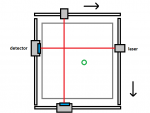- Joined
- Jul 6, 2010
- Messages
- 27
- Points
- 0
Hello All!
I am working on a scanning experiment, and had a question about using lasers to find the location of the specimen inside the scanning head. I was planning to use two lasers, which would project a laser grid onto both sides of the sample, from both sides of the main optical train:
____________
|->SAMPLE<-|
I would wish to visualize this grid with two webcams, which could then track relative specimen position to scanner rotation and elevation.
First question: is this idea valid? Is there some easier way to find irregular specimens to milimeter (or less) precision with similar cost (as opposed to simply using a LEAP motion?)
Second question: how would one make this grid, which will ideally be regular and in the range of millimeters? Would shining a line laser through a diffraction grating produce this effect, or would I have to use some sort of XY scanning galvanometer arrangement piped through a fiber?
Any ideas would be much appreciated!
Kind Regards,
Ivan Kozlov
I am working on a scanning experiment, and had a question about using lasers to find the location of the specimen inside the scanning head. I was planning to use two lasers, which would project a laser grid onto both sides of the sample, from both sides of the main optical train:
____________
|->SAMPLE<-|
I would wish to visualize this grid with two webcams, which could then track relative specimen position to scanner rotation and elevation.
First question: is this idea valid? Is there some easier way to find irregular specimens to milimeter (or less) precision with similar cost (as opposed to simply using a LEAP motion?)
Second question: how would one make this grid, which will ideally be regular and in the range of millimeters? Would shining a line laser through a diffraction grating produce this effect, or would I have to use some sort of XY scanning galvanometer arrangement piped through a fiber?
Any ideas would be much appreciated!
Kind Regards,
Ivan Kozlov






